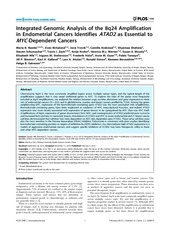| dc.contributor.author | Ræder, Maria B. | en_US |
| dc.contributor.author | Birkeland, Even | en_US |
| dc.contributor.author | Trovik, Jone | en_US |
| dc.contributor.author | Krakstad, Camilla | en_US |
| dc.contributor.author | Shehata, Shyemaa | en_US |
| dc.contributor.author | Schumacher, Steven | en_US |
| dc.contributor.author | Zack, Travis I. | en_US |
| dc.contributor.author | Krohn, Antje | en_US |
| dc.contributor.author | Werner, Henrica Maria Johanna | en_US |
| dc.contributor.author | Moody, Susan E. | en_US |
| dc.contributor.author | Wik, Elisabeth | en_US |
| dc.contributor.author | Stefansson, Ingunn | en_US |
| dc.contributor.author | Holst, Frederik | en_US |
| dc.contributor.author | Øyan, Anne Margrete | en_US |
| dc.contributor.author | Tamayo, Pablo | en_US |
| dc.contributor.author | Mesirov, Jill P. | en_US |
| dc.contributor.author | Kalland, Karl-Henning | en_US |
| dc.contributor.author | Akslen, Lars A. | en_US |
| dc.contributor.author | Simon, Ronald | en_US |
| dc.contributor.author | Beroukhim, Rameen | en_US |
| dc.contributor.author | Salvesen, Helga Birgitte | en_US |
| dc.date.accessioned | 2014-01-14T13:49:41Z | |
| dc.date.available | 2014-01-14T13:49:41Z | |
| dc.date.issued | 2013-02-05 | eng |
| dc.Published | PLoS ONE 8(2): e54873 | eng |
| dc.identifier.issn | 1932-6203 | |
| dc.identifier.uri | https://hdl.handle.net/1956/7672 | |
| dc.description.abstract | Chromosome 8q24 is the most commonly amplified region across multiple cancer types, and the typical length of the amplification suggests that it may target additional genes to MYC. To explore the roles of the genes most frequently included in 8q24 amplifications, we analyzed the relation between copy number alterations and gene expression in three sets of endometrial cancers (N = 252); and in glioblastoma, ovarian, and breast cancers profiled by TCGA. Among the genes neighbouring MYC, expression of the bromodomain-containing gene ATAD2 was the most associated with amplification. Bromodomain-containing genes have been implicated as mediators of MYC transcriptional function, and indeed ATAD2 expression was more closely associated with expression of genes known to be upregulated by MYC than was MYC itself. Amplifications of 8q24, expression of genes downstream from MYC, and overexpression of ATAD2 predicted poor outcome and increased from primary to metastatic lesions. Knockdown of ATAD2 and MYC in seven endometrial and 21 breast cancer cell lines demonstrated that cell lines that were dependent on MYC also depended upon ATAD2. These same cell lines were also the most sensitive to the histone deacetylase (HDAC) inhibitor Trichostatin-A, consistent with prior studies identifying bromodomain-containing proteins as targets of inhibition by HDAC inhibitors. Our data indicate high ATAD2 expression is a marker of aggressive endometrial cancers, and suggest specific inhibitors of ATAD2 may have therapeutic utility in these and other MYC-dependent cancers. | en_US |
| dc.language.iso | eng | eng |
| dc.publisher | Public Library of Science | eng |
| dc.relation.ispartof | <a href="http://hdl.handle.net/1956/7673" target="blank">Mutations and gene amplifications in Endometrial Carcinomas. “Clinical characteristics and potential targets for therapy related to KRAS, MYC, ATAD2, PIK3CA and FGFR2 alterations”</a> | eng |
| dc.rights | Attribution CC BY | eng |
| dc.rights.uri | http://creativecommons.org/licenses/by/3.0/ | eng |
| dc.title | Integrated Genomic Analysis of the 8q24 Amplification in Endometrial Cancers Identifies ATAD2 as Essential to MYC-Dependent Cancers | en_US |
| dc.type | Peer reviewed | |
| dc.type | Journal article | |
| dc.description.version | publishedVersion | en_US |
| dc.rights.holder | Copyright 2013 Raeder et al. | |
| dc.source.articlenumber | e54873 | |
| dc.identifier.doi | https://doi.org/10.1371/journal.pone.0054873 | |
| dc.identifier.cristin | 1025082 | |
| dc.source.journal | PLoS ONE | |
| dc.source.40 | 8 | |
| dc.source.14 | 2 | |

